Strategies for saving fuel
Squeezing every last drop
As diesel prices continue to hover near $4 a gallon, it’s more important than ever for fleets to get the most out of every last drop of fuel purchased at the lowest possible cost. Many methods are available to keep fuel costs to a minimum — some obvious, some not so much. Although most fleets are pursuing some fuel-saving strategies, few would score 100 percent for using every practical method.
possible cost. Many methods are available to keep fuel costs to a minimum — some obvious, some not so much. Although most fleets are pursuing some fuel-saving strategies, few would score 100 percent for using every practical method.
Truck and engine manufacturers continue to innovate in the improvement of fuel economy, but the low-hanging fruit in this realm is long gone. Any gains at the factory level will only amount to fractions of a percent, so beyond a bit of guidance in proper spec’ing, most of the burden of improving fuel economy rests on fleet managers’ shoulders.
Driving savings
It has been proven time and time again that driving habits can have as much as a 30 percent impact on fuel economy, yet few fleets track mpg statistics by driver, and of those that do, fewer still have any sort of fuel economy incentive programs in place. Most distributors would move heaven and earth to trim 30 percent from any other operating cost, yet few even try to work with drivers in a meaningful way to cut fuel costs.
Some fleets will cite the practice of switching drivers between trucks, or switching trucks between routes, as an obstacle to tracking a driver’s fuel economy. Although there is plenty of technology available to overcome this obstacle, a simpler alternative might be to base the incentive program on fleet-wide fuel economy improvement or a competition between operating divisions.
Maximum operating speed also can have a profound effect on fuel economy, so many fleet managers do spec a truck’s electronic speed limiter to kick in somewhere between 55 and 65 mph. The trouble is that most route delivery operations rarely involve open stretches where top speed becomes a factor.
In practice, how quickly a driver gets up to speed can have far more impact on fuel economy than top speed, mainly because it’s a far more common occurrence. On many trucks, the same engine control computer that makes top-speed settings possible also can limit acceleration to prevent “jackrabbit” starts. Not only does this save fuel, but it also can dramatically reduce drivetrain damage.
Regardless of how efficiently a driver operates the truck while under way, still more fuel can be saved by eliminating unnecessary engine idling. Another feature of most modern engine control computers is the ability to set a time limit on idling while in park — typically between five and 10 minutes. Many fleets do take advantage of this feature, but just as many do not, primarily for cab/cargo temperature-related reasons.
Here again, plenty of technology is available to overcome this obstacle. No-idle air conditioning systems are available to keep the cab at driver-friendly temperatures in the warmer climates, and a fuel-fired heater can keep both the engine and cab warm in cold climates using one-tenth of the fuel consumed by idling the engine.
Out back in the cargo bay, newer hybrid refrigeration systems can be run with shore-power at home base, powered by the truck while under way, and with stored energy while parked at a delivery location.
Routing and loading optimization is another area where fuel costs can be dramatically reduced. Although improving fuel economy on the road and reducing unnecessary engine idling can get more miles out of a gallon of fuel, one of the easiest ways to save fuel is by eliminating miles altogether.
Optimizing cargo body/trailer configurations, combined with loading and routing to deliver the maximum amount of product while traveling the minimum number of miles, can result in wholesale reductions in fuel consumption.
But even for the most efficiently run fleets, the price paid for fuel still can have a major effect on the bottom line. Many of the smallest fleets overlook negotiating a volume purchase discount. A fleet with a few trucks will end up purchasing far more fuel than the average retail customer, so even the smallest of fuel vendors are likely to negotiate a discount from the posted retail price.
For all but the smallest fleets, the combination of fuel management software and an effective fuel management strategy can optimize the entire fuel chain by ensuring supply, negotiating pricing, reconciling charges, and tracking and cost-accounting for the fuel used. Inventory management, environmental compliance and dispensing control also are key strategic elements for fleets with on-site fueling capabilities.
Looking for a reprint of this article?
From high-res PDFs to custom plaques, order your copy today!






